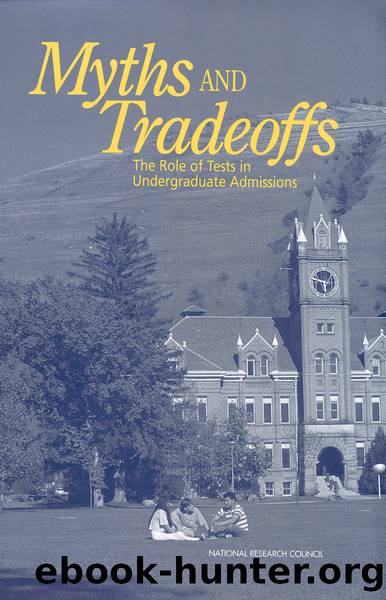Myths and Tradeoffs: The Role of Tests in Undergraduate Admissions by National Research Council

Author:National Research Council
Language: eng
Format: epub
Tags: Education : Higher Education. Education : Testing, Assessments and Standards
Publisher: NATIONAL ACADEMY PRESS
Published: 1999-07-28T00:00:00+00:00
The SAT
The SAT I was conceived as a means of identifying the likelihood that students with a wide range of academic preparation could successfully do college-level work.1 It was designed to measure verbal and mathematical reasoning by means of multiple-choice questions. (The mathematics section also includes some machine-scorable items in which the students generate answers and record them on a grid.) In its current form, the test devotes 75-minutes to the verbal section and 60-minutes to the mathematics section.2 The verbal questions are of three kinds (descriptions from College Board materials quoted in Jaeger and Wightman, 1998:32):
1 SAT I and SAT II are the current names for what used to be two separate testing programs, the SAT, Scholastic Aptitude Test, and the Achievement Tests. The SAT II (Achievement Testing Program) is a set of tests in academic subjects. Though these tests are used in the college admissions process, their role varies widely and has not generated the controversies that the SAT I has; they are not addressed in this report.
Download
This site does not store any files on its server. We only index and link to content provided by other sites. Please contact the content providers to delete copyright contents if any and email us, we'll remove relevant links or contents immediately.
The Art of Coaching Workbook by Elena Aguilar(50996)
Trainspotting by Irvine Welsh(21521)
The Secret History by Donna Tartt(18857)
Twilight of the Idols With the Antichrist and Ecce Homo by Friedrich Nietzsche(18508)
All the Missing Girls by Megan Miranda(15590)
Cat's cradle by Kurt Vonnegut(15189)
Ready Player One by Cline Ernest(14531)
Talking to Strangers by Malcolm Gladwell(13232)
Fangirl by Rainbow Rowell(9100)
The remains of the day by Kazuo Ishiguro(8828)
The Compound Effect by Darren Hardy(8817)
Thirteen Reasons Why by Jay Asher(8800)
Tools of Titans by Timothy Ferriss(8223)
Periodization Training for Sports by Tudor Bompa(8173)
Wonder by R. J. Palacio(8014)
The Lover by Duras Marguerite(7834)
A Court of Wings and Ruin by Sarah J. Maas(7653)
Change Your Questions, Change Your Life by Marilee Adams(7638)
The Complete Stick Figure Physics Tutorials by Allen Sarah(7310)
